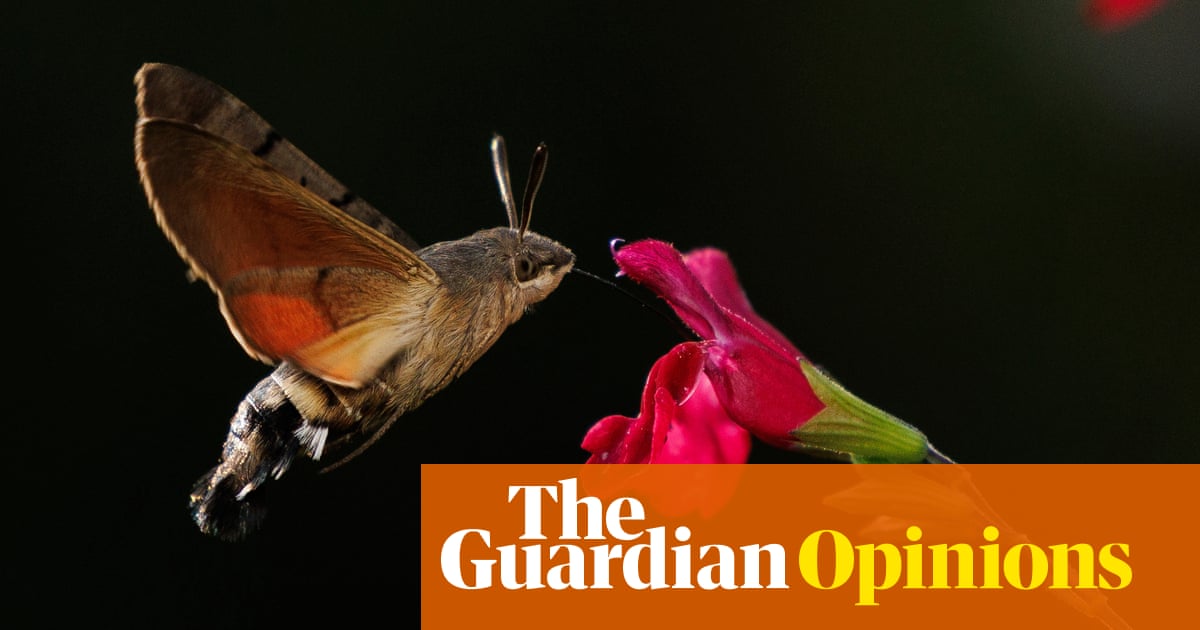Let me start with a confession: I love moths. If your instant reaction to that statement is a shudder and expression of dislike (or worse), be assured that you’re not alone. It is the commonest response I get. But before you scroll on or turn the page, I hope you will give me a couple of minutes of your time to persuade you to change your mind. Moths are extremely important and beautiful creatures, and we should all love them.
Almost all of them, anyway. There’s a couple of tiny species that nibble holes in your jumpers and chew your carpets, and I’m not going to try to make you love those. Feel free to hate them with a vengeance, particularly as autumn draws in and you open your jumper drawer to find unwanted evidence of their labours. But Britain has about 2,500 other species of moths, and it would be unfair to let the clothes moths colour your perceptions of the other 99.9%. And the others really are special, in all sorts of ways.
First of all, moths are stunningly beautiful animals. Take the merveille du jour: a velvety plush of green, black and white, perfectly camouflaged to hide on a patch of lichen, but fabulous on any background. The puss moth is a thumb-sized swatch of ermine fur coat. The burnished brass looks a colourless blob when angled away from you, but turn it sideways and its metallic sheen is revealed, more gilded than its name implies. The elephant hawk-moth is candy-striped gold and bubblegum pink, and larger than most British butterflies.
Ah, the B word. It usually quickly comes up in any conversation I have about moths. People who hate moths will readily profess a love of butterflies. But butterflies are just a group of moths that took to flying by day – asking the difference between butterflies and moths is equivalent to asking the difference between primates and mammals. They’re a distinct subgroup, but still just a subgroup. And while we have about 70 butterfly species in Britain, we have more than 150 (other) day-flying moth species. With splashes of colour such as the cinnabar or speckled yellow, or honorary vertebrates such as the hummingbird hawk-moth (even the species that are “just” shades of brown sport intricate patterns), they surpass butterflies in diversity and beauty.
We can love them for their looks, but moths are also critical components of the wider web of life. One in 10 of all known species worldwide is a moth. This success is underpinned by the ability of their caterpillars to convert plant tissue into flesh. Many other animals depend on the resulting bounty. If we didn’t have moths, we wouldn’t have most of our favourite garden birds. During the breeding season when they are feeding hungry broods, great tits and blue tits alone consume upwards of 2 billion insects every day, many of which are moths (caterpillars mainly, but also adults).
Species such as robins, wrens, blackbirds, sparrows and cuckoos all rely on moths to survive and raise their young, as do many species of bat and other mammals such as hedgehogs. All these predators motivate the astonishing camouflage of species like the merveille du jour, and others that mimic broken sticks (buff-tip, flame), bird poo (chinese character, scorched carpet), wasps (hornet moth) or other predators (eyed hawk-moth, emperor). The scales on moth wings can even absorb or scatter sonar to confuse bats. It is a natural arms race going on over our heads every day.
Many animals depend on moths, but so too do many plants. A key development in the evolutionary history of moths was the proboscis, allowing the adults to imbibe water and sap. Plants have exploited this by producing flowers filled with sugary nectar to attract these drinkers, with the quid pro quo of pollination to secure future plant generations. It is probably no coincidence that about 50-100m years ago, flowering plant and moth diversity exploded in tandem. Many moths carry pollen, and some plants only get it delivered by moths.
Recent studies suggest that moths visit as many species by night as honeybees and bumblebees do by day, and the flowers of many of our crop species are included in their rounds. It’s a racing certainty that moths are important pollinators, for plants and for us – yet, we are only just beginning to understand their role because most of our studies of insects that visit flowers (such as the pollinator monitoring scheme, for example) are carried out in daylight. Moths are probably as important as bees, just mostly going about their work secretly in the dark.
So moths are jewels of our natural heritage, and vital links in the web of life that includes you and me. They are as beautiful as butterflies and as industrious as bees – insects we rightly revere. Yet, there is still so much that we don’t know about them. In recent years, we have found new (to science) moth species in Ealing and on Hampstead Heath in London. Who knows what may be lurking in your garden, and what role they may play for the world we inhabit? We do know that moth populations overall have declined by 33% since 1970, and that losses are continuing.
Yes, a couple of species might make holes in your clothes, but an absence of moths would leave holes in the fabric of nature that would matter infinitely more. If I haven’t persuaded you to love them as much as I do, I hope at least I have convinced you that moths deserve to be loved.
